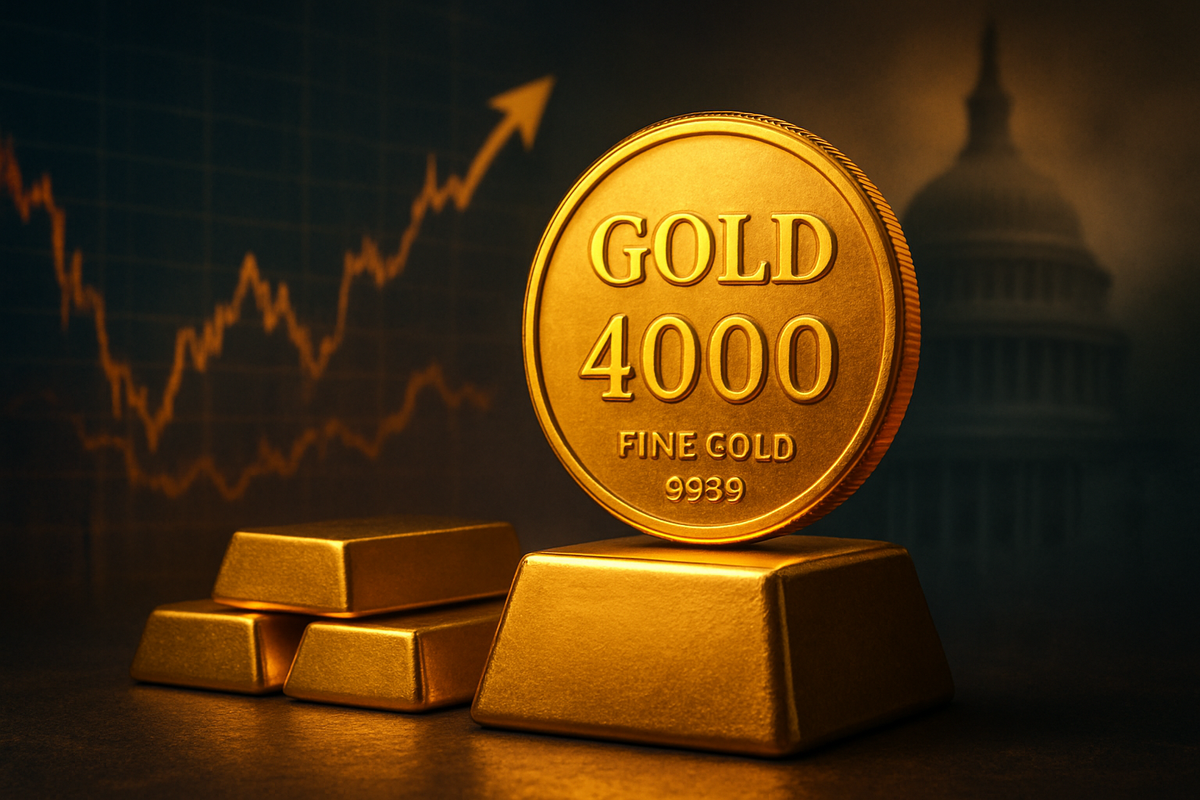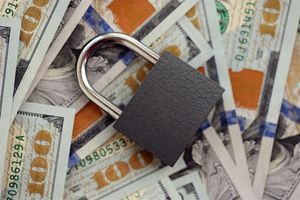
New York, NY – October 7, 2025 – In a historic market event, gold futures surged past the unprecedented $4,000 per ounce mark today, reaching as high as $4,013 in New York trading. This monumental rise underscores a profound shift in investor sentiment, as global financial markets grapple with escalating uncertainties, most notably the ongoing U.S. government shutdown. The precious metal, long revered as a safe haven, has witnessed a remarkable 50% climb since the beginning of 2025, culminating in this record-breaking achievement that reflects a deepening anxiety among investors seeking refuge from economic instability.
The seven-day U.S. government shutdown has cast a long shadow over the economy, disrupting the release of crucial economic data and fueling a palpable sense of unease. This environment has significantly amplified gold's traditional role, prompting a substantial "flight to safety" as investors flock to assets perceived to be immune to political gridlock and market volatility. The record-breaking price is a clear indicator that confidence in conventional financial instruments and policy stability is waning, pushing capital into the tangible security of gold.
Unpacking the Historic Ascent: A Confluence of Crises
The ascent of gold futures above $4,000 per ounce on October 7, 2025, was not merely a single market spike but the culmination of several potent economic and political forces. The most immediate catalyst remains the protracted U.S. government shutdown, which has paralyzed federal agencies and introduced an alarming degree of unpredictability into the world's largest economy. This political stalemate has not only delayed vital economic indicators but has also eroded investor confidence in the nation's ability to manage its fiscal affairs, leading to widespread speculation about potential long-term economic repercussions. Peter Grant, Vice-President and Senior Metals Strategist at Zaner Metals, highlighted the "ongoing safe-haven flows stemming in part from the government shutdown and no real indication that it is likely to be resolved in the immediate term here," perfectly encapsulating the prevailing market sentiment.
Beyond the domestic political turmoil, a broader landscape of global economic uncertainty and geopolitical tensions has provided fertile ground for gold's rally. Persistent inflation fears, despite central bank efforts, continue to prompt investors to seek inflation hedges. Furthermore, expectations of further interest rate cuts by the U.S. Federal Reserve, following a September reduction and anticipated further easing, have made non-yielding gold a more attractive proposition compared to interest-bearing assets whose returns are diminishing. The Fed's accommodative stance, while intended to stimulate growth, inadvertently bolsters gold's appeal by reducing the opportunity cost of holding the metal.
The timeline leading to this moment has been characterized by a steady build-up of pressures throughout 2025. From the start of the year, global economic indicators hinted at a slowdown, exacerbated by President Donald Trump's aggressive trade policies and tariffs, which created significant friction in international commerce. Geopolitical flashpoints, including political upheaval in France and Japan, further unsettled currency and bond markets, diverting capital towards gold. Key players, ranging from individual retail investors to major central banks, have been actively accumulating gold. Central banks, in particular, have been robust purchasers, seeking to diversify reserves and hedge against potential U.S. sanctions or global financial instability, further solidifying gold's fundamental demand. This confluence of factors has created a perfect storm, propelling gold to levels previously thought unimaginable.
Initial market reactions have been a mix of awe and concern. While gold bugs celebrate the validation of their long-held belief in the metal's enduring value, broader equity markets have shown signs of nervousness. The significant capital outflow from riskier assets into gold suggests a defensive posture among investors, signaling a potential slowdown in economic activity and a re-evaluation of growth prospects across various sectors. The record high in gold serves as a stark barometer of current market anxieties, indicating that investors are prioritizing capital preservation over aggressive growth strategies.
Companies Navigating the Golden Surge: Winners and Losers
The unprecedented surge in gold prices to over $4,000 per ounce is creating a distinct bifurcation within the market, carving out clear winners and potential losers. Unsurprisingly, gold mining companies stand to be the primary beneficiaries, as their core product appreciates dramatically in value. Companies like Barrick Gold (NYSE: GOLD) and Newmont Corporation (NYSE: NEM) are poised for substantial revenue and profit increases. Higher gold prices directly translate to fatter margins for miners, especially those with lower production costs. This could lead to increased exploration budgets, expanded mining operations, and potentially higher dividends for shareholders. Investors are likely to scrutinize these companies' balance sheets and operational efficiencies to identify those best positioned to capitalize on the elevated price environment.
However, the ripple effects extend beyond the mining sector. Companies involved in gold streaming and royalty agreements, such as Franco-Nevada (NYSE: FNV), will also see their revenue streams swell. These firms provide upfront capital to miners in exchange for a percentage of future gold production or revenue, and a higher gold price directly boosts the value of their existing contracts. Furthermore, companies in the precious metals refining and trading space could also experience increased activity and profitability, as the volume and value of gold transactions surge.
Conversely, the broader economic implications of sustained high gold prices, driven by investor anxiety and economic uncertainty, could negatively impact sectors sensitive to consumer confidence and economic growth. Retailers, discretionary consumer goods manufacturers, and companies in the travel and leisure industries might face headwinds if consumers tighten their belts in response to perceived economic instability. Financial institutions, particularly those heavily invested in equity markets or exposed to credit risk, could also experience challenges if the flight to safety signals a broader economic downturn or increased default rates. The shift of capital into gold often means a corresponding withdrawal from other asset classes, potentially impacting valuations across the board and making it harder for companies in growth sectors to attract investment.
Moreover, companies that rely on stable and predictable economic conditions for their business models, such as those in manufacturing or large-scale infrastructure projects, may find themselves operating in a more challenging environment. The U.S. government shutdown, a key driver of gold's rise, itself creates operational uncertainties and delays for businesses that interact with federal agencies or rely on government contracts. This complex interplay means that while gold miners celebrate, many other public companies may need to strategically adapt to a market characterized by heightened caution and a preference for capital preservation.
Wider Significance: A Barometer of Global Unease
The historic breach of the $4,000 mark by gold futures transcends a mere price point; it serves as a potent barometer of deepening global economic and political unease. This event fits squarely into broader industry trends emphasizing risk aversion, diversification away from traditional fiat currencies, and a growing skepticism towards government stability. The demand for safe-haven assets has been steadily climbing in recent years, fueled by geopolitical tensions, trade disputes, and persistent inflation concerns, and this latest surge in gold prices merely amplifies an existing trajectory. It signifies a collective investor response to a world perceived as increasingly unpredictable, where tangible assets offer a psychological and financial hedge against unseen risks.
The potential ripple effects on competitors and partners are substantial. For other safe-haven assets like government bonds, particularly U.S. Treasuries, the gold rally presents a complex dynamic. While Treasuries also benefit from a flight to safety, the reason for gold's surge—a U.S. government shutdown—could simultaneously undermine confidence in U.S. sovereign debt, potentially leading to increased yields as investors demand higher compensation for perceived risk. This could create a challenging environment for fixed-income markets globally. Furthermore, the elevated gold price could put pressure on the U.S. dollar, as investor confidence shifts away from the currency of a government in shutdown, potentially leading to a weakening of the greenback against other major currencies or commodities.
Regulatory and policy implications are also significant. A prolonged U.S. government shutdown, directly implicated in gold's rise, can lead to a cascade of negative effects, including delayed economic data, hampered regulatory oversight, and a general slowdown in government services. This instability could prompt calls for more robust fiscal responsibility and potentially influence future legislative efforts to prevent similar shutdowns. Central banks globally might also re-evaluate their monetary policies, especially if the underlying economic anxieties persist, potentially leading to further interest rate adjustments or unconventional measures to stabilize markets.
Historically, gold has always performed strongly during periods of crisis and uncertainty. Comparisons can be drawn to the 2008 financial crisis or even the early 1970s when the U.S. abandoned the gold standard. During the 2008 crisis, gold prices soared as investors sought refuge from collapsing financial institutions and a global economic recession. Similarly, past government shutdowns, though not leading to such dramatic gold surges, have consistently seen an uptick in safe-haven demand. This current event, however, is unique in its magnitude, suggesting that the confluence of a government shutdown, persistent inflation, and broader geopolitical instability has created an unprecedented level of investor anxiety, propelling gold into uncharted territory.
What Comes Next: Navigating the Golden Horizon
The immediate aftermath of gold futures crossing the $4,000 threshold will likely see continued volatility and intense scrutiny. In the short term, the price of gold will remain highly sensitive to developments surrounding the U.S. government shutdown. A swift resolution could temper some of the safe-haven demand, potentially leading to a modest correction. However, a prolonged shutdown or any escalation of political gridlock would almost certainly provide further impetus for gold to consolidate its gains or even push higher. Investors should also closely watch central bank rhetoric and actions, particularly from the U.S. Federal Reserve; any unexpected shifts in interest rate policy or quantitative easing measures could significantly impact gold's trajectory.
Looking further ahead, the long-term possibilities for gold are tied to the broader macroeconomic landscape. If global economic growth remains sluggish, inflation persists, and geopolitical tensions continue to simmer, gold's role as a store of value will remain paramount. This could establish a new, higher baseline for gold prices, making previous resistance levels new support zones. Conversely, a sustained period of robust global growth, coupled with declining inflation and geopolitical stability, could diminish some of gold's allure, though its intrinsic value and historical significance as a hedge are unlikely to ever fully dissipate.
This environment presents both market opportunities and challenges. For investors, the opportunity lies in strategically allocating capital to gold and related assets, potentially through ETFs, physical bullion, or shares in well-managed gold mining companies. However, the challenge is managing the inherent volatility and avoiding speculative bubbles. For public companies, particularly those outside the precious metals sector, the challenge is adapting to an investment climate where capital is increasingly risk-averse. This may require strategic pivots towards more resilient business models, stronger balance sheets, and clear communication of value proposition to investors prioritizing stability.
Potential scenarios range from a "soft landing" where the shutdown resolves quickly and economic confidence slowly returns, leading to a gradual rebalancing of portfolios, to a "hard landing" where the shutdown exacerbates existing economic vulnerabilities, potentially triggering a broader market downturn and further driving capital into gold. Another scenario involves a "new normal" where high gold prices become a permanent feature, reflecting a fundamental shift in how investors perceive risk and value in a volatile global economy. Investors should monitor not only the political landscape but also broader economic indicators like inflation rates, GDP growth, and employment figures, as these will ultimately dictate gold's long-term performance.
A Comprehensive Wrap-Up: Gold's Enduring Message
The monumental rise of gold futures above $4,000 per ounce on October 7, 2025, serves as a powerful and unambiguous signal from the financial markets. The key takeaway is the profound level of anxiety permeating the global investment community, driven primarily by the ongoing U.S. government shutdown and a broader spectrum of economic and geopolitical uncertainties. This event unequivocally reaffirms gold's timeless role as the ultimate safe haven, a tangible asset that investors instinctively turn to when confidence in fiat currencies, government stability, and traditional markets falters. It's a stark reminder that in times of crisis, the allure of intrinsic value often outweighs the promise of growth from riskier ventures.
Moving forward, the market will undoubtedly remain on edge, with gold prices acting as a sensitive barometer for the resolution of the U.S. government shutdown and the trajectory of global economic health. While a resolution to the political impasse could temporarily alleviate some pressure on gold, the underlying factors that propelled it to this record high—persistent inflation concerns, geopolitical instability, and a general erosion of trust in institutional stability—are unlikely to vanish overnight. This suggests that even if gold experiences short-term pullbacks, its fundamental appeal as a hedge against systemic risk will endure, potentially establishing a new, higher trading range for the metal.
The lasting impact of this event will likely be a reinforced conviction among investors about the necessity of portfolio diversification, with a greater emphasis on assets that offer protection against unforeseen shocks. It highlights the fragility of an interconnected global economy and the significant influence of political decisions on market sentiment. For public companies and policymakers alike, the message is clear: stability and predictability are paramount, and their absence will inevitably drive capital towards perceived safety, away from productive investments.
Investors should watch for several key indicators in the coming months: the duration and resolution of the U.S. government shutdown, any shifts in global central bank policies regarding interest rates and inflation targets, and the evolution of major geopolitical flashpoints. The $4,000 gold barrier is more than just a number; it's a profound statement about the current state of global financial health and the collective psyche of anxious investors navigating an uncertain future.
This content is intended for informational purposes only and is not financial advice.





